Research on Agricultural Activities and Energy Consumption
in a Rural Area in Ngororero District
(Research results)
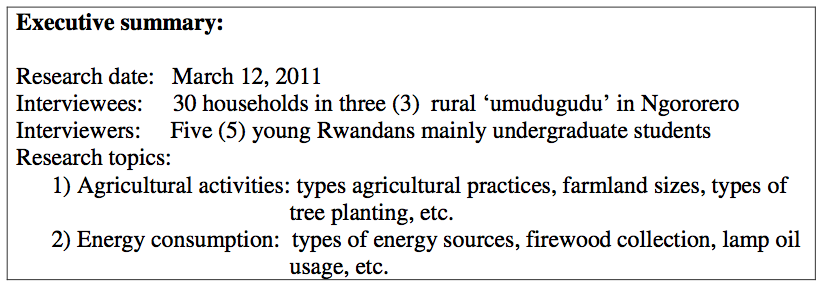
1. Introduction
Rwanda is the most densely populated country in Africa. There is an accelerated rate of population growth. This has created a huge demand for energy sources. The major challenge the energy industries are facing in Rwanda is to satisfy a general demand rise of energy usage. There is therefore a need to re-direct the national planning and research strategies away from the traditional energy production system, which consists of expansive firewood collection hence destroying the environment.
The purpose of this survey is to capture and understand an average lifestyle in a rural area in Rwanda about people’s energy consumption tendencies. Additionally, we have obtained information about their typical agricultural activities.
The survey was conducted in three (3) different ‘umudugudu’ (the smallest administrative block in Rwanda consisting about 50 households) namely; CYAMBOGO, GAKOMA and BIRAMBO. They were randomly selected from three (3) different Cells (i.e. a one-level bigger administrative block than umudugudu) which were TSIBO, GASEKE and BAMBIRO in Nyange Sector located in Ngororero District of the Western Province.
The research was done on March 12, 2011 by interviewing 30 community people in the targeted three (3) umudugudu. The interviews were conducted by five (5) young Rwandan researchers, who were mainly undergraduate students.
2. Research results
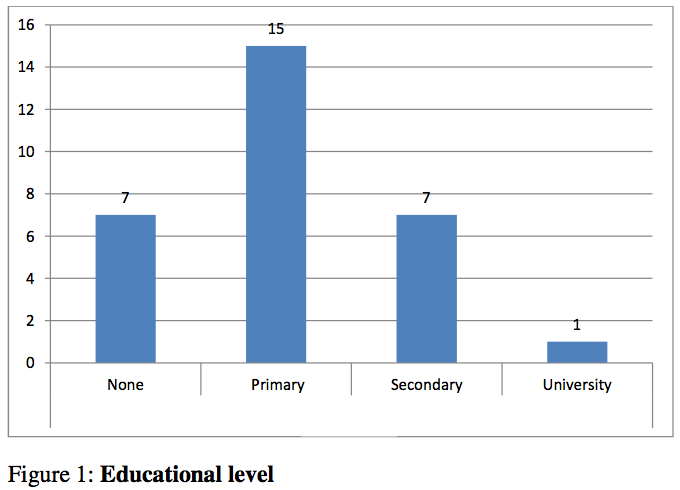
The results obtained indicates that among 30 people interviewed, only 15 equivalents to 50% have primary-level of education, seven (7) have the secondary level, one (1) person joined the university, and seven (7) people did not join any level of education (illiterate) as illustrated in Figure 1 above.
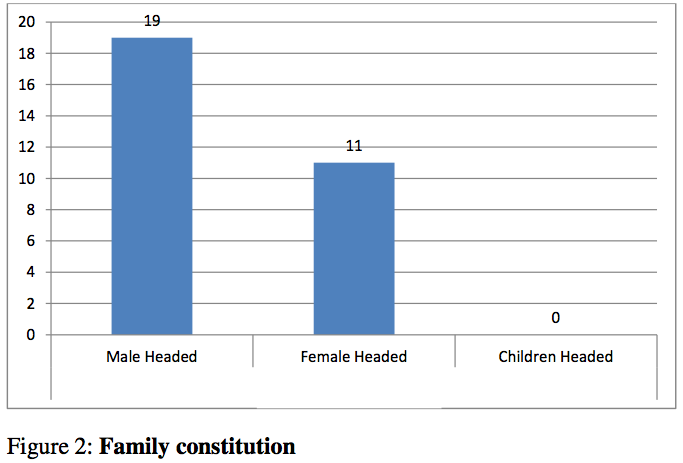
During this survey, the result was revealed that 19 families were headed by males, 11 families were headed by females, and no families were headed by children (ref. Figure 2).
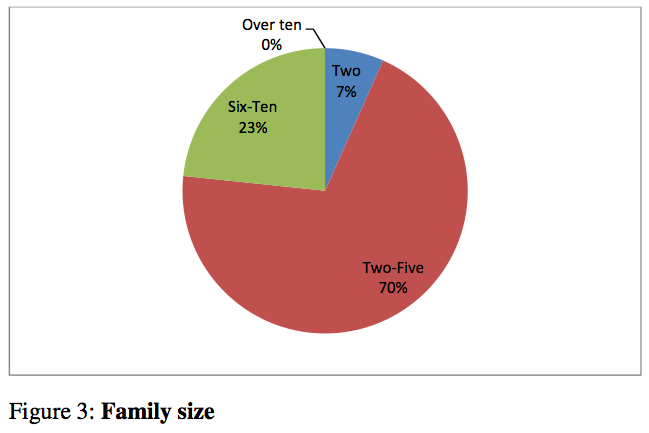
A survey result indicates that 70% of interviewed families consisted of family members between two (2) and five (5), 23% between six (6) and 10, 7% only two (2) people, and 0% over ten people.
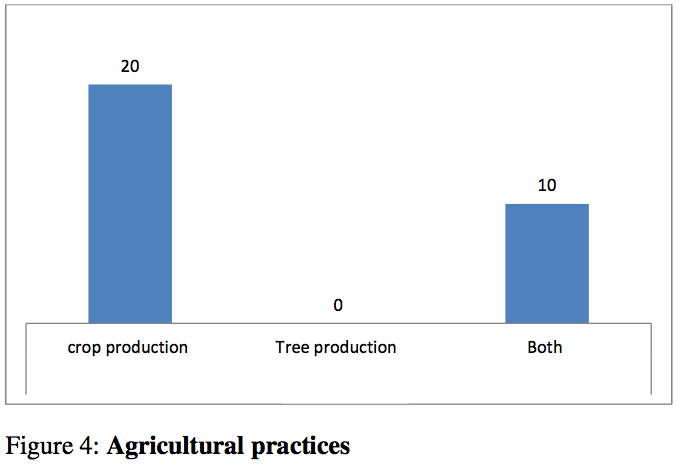
The figure 4 above illustrates that Ngororero farmers do not only practice tree production. On the other hand, 67% of the farmers practice crop production and 33% do practice both tree production and crop production. This may be due to limited land; only small land is available for food production to fight against hunger.
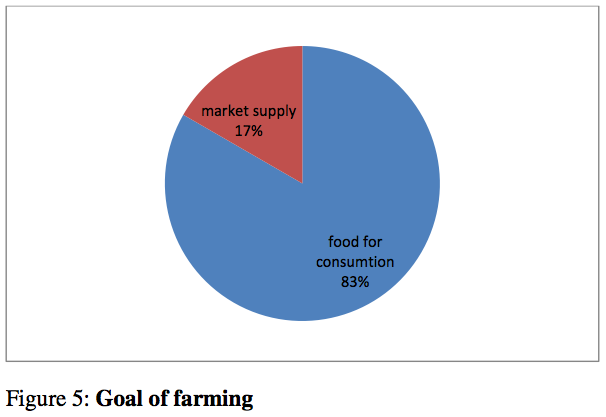
According to the pie chart above, 83% of farmers in Nyange sector interviewed produce crops for their own food consumption, and only 17% grow crops targeting the market (market-oriented crop farming).
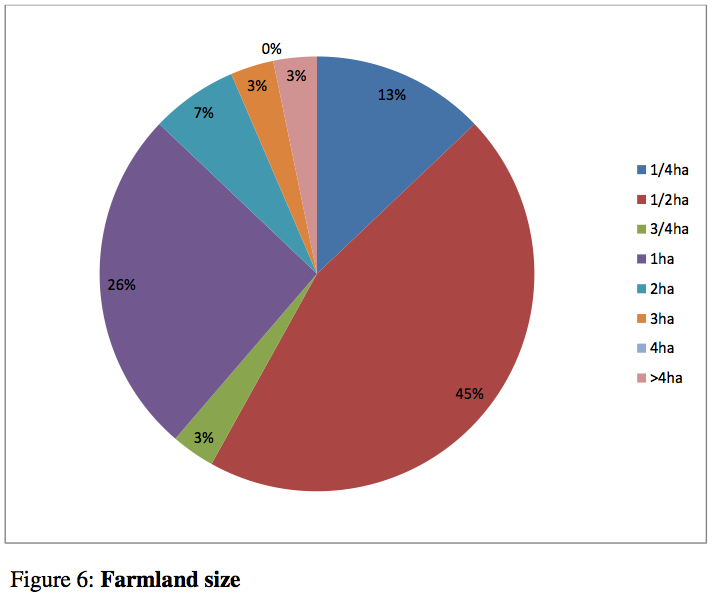
The majority of farmers in Nyange sector possesse a half hectare of land which is very small. This leads to low outputs hence leaving the citizens in the permanent state of having not enough agricultural yields. 45% of the farmers do crop and cattle farming at the area of 1⁄2 ha. 26% only use 1ha and 13% do farming at the area of 1/4ha. On the contrary, one farmer among 30 farmers interviewed has more than 4ha equivalent to 3%, and another 3% possess 3ha and 7% do agriculture at the land of 2ha.
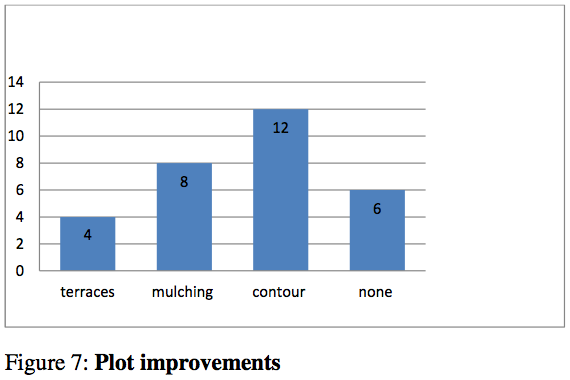
Among 30 people interviewed only 12 do plot improvements on their crop fields by contouring the farms targeting good yields to satisfy their needs. Eight (8) people do mulching on their farms to maintain soil moisture and four (4) people try terracing to control water runoff against damaging crops in the field. Surprisingly, six (6) people out of 30 interviewed do not practice any plot improvements on their farms. This very big number of people equivalent to 20% lack efforts of plot improvements resulting in soil erosion on their farms, and hence low crop yields consequently. So, farmers should be encouraged to do plot improvements to keep their environment safe as well as increasing crop yields.
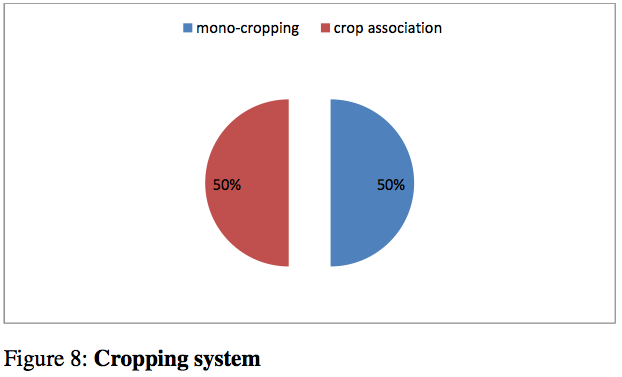
The following crops are generally grown by farmers in Ngororero district:
Banana, cassava, yam, potatoes, vegetables, beans and maize
They are allocating crops according to the two common systems which are mono- cropping and crop association. The majority intercrop banana, beans, and yam. Others mix maize and beans, and some do intercrop yam and banana. For the case of mono-cropping, cassava plantation is normally separated from other crops, and potatoes and vegetables are also practiced separately. That is a common farming method in Nyange sector.
The chart above is showing that among farmers in Nyange sector, 50% practice agriculture by using the mono-cropping system while 50% do farming by using the crop association system.
So it is highly recommended to encourage the crop association method more, where intercropping works better without hindering performance of the others. Further, correct interspacing to allow good aeration is seriously needed.
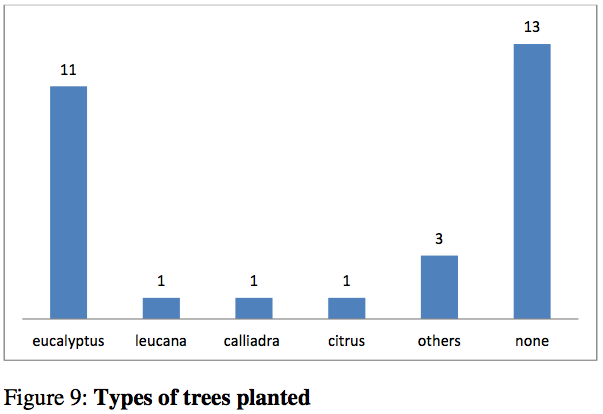
One farmer grows leucana, one calliadra and one citrus among 30 farmers interviewed in Nyange sector of Ngororero district. According to the graph above, 13 farmers do not grow any tree on their farms and 11 do grow eucalyptus and three (3) are trying other species different from the above-mentioned species.
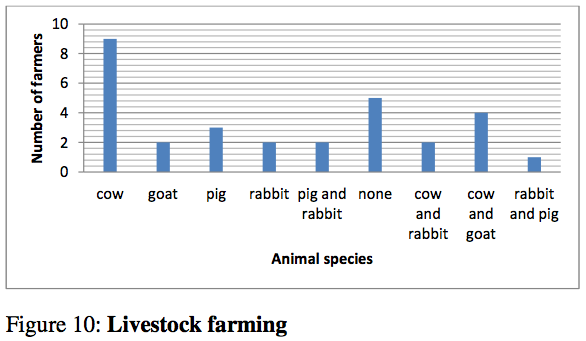
Two (2) farmers keep two (2) goats, two (2) keep rabbits, two (2) keep pigs and rabbits, and two (2) keep cows and rabbits according to the graph above. Five (5) farmers do not keep any animal species. Nine (9) farmers keep cows and the cow is the most dominant animal species kept by farmers in Ngororero district.
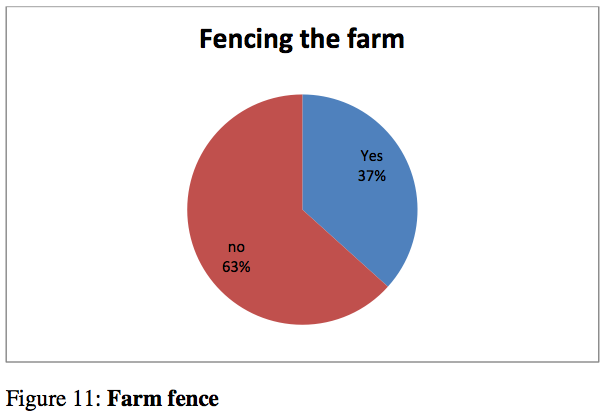
The result shows that 63% of the interviewed farmers do not have any fence on their farms meaning that any animals can invade their plantation for crop destruction. So, it might be an opportunity to introduce Jatropha as live hedges on their farms targeting crop protection from animals as well as creating an energy source and enhancing a soil erosion control. In contrast, 37% of interviewed people have fences on their farms. 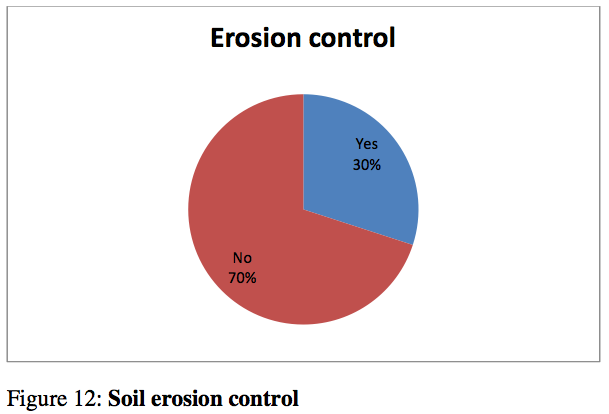
The majority (70%) of the interviewed farmers responded that no erosion control measures are put in place. Only 30% of contacted farmers responded yes on erosion control.
The farmers should be encouraged and trained on how good it is to control erosion on their farmlands. Negative impacts of soil erosion should be fully explained by indicating which part of the land is vulnerable. Also, it should be understood well by the farms that once top soil is washed away, an infertile part of land remains and heavy inputs like chemical fertilizers would become necessary, which will increase the farm operational cost and let the farmers be in a difficult situation to make their ends meet.
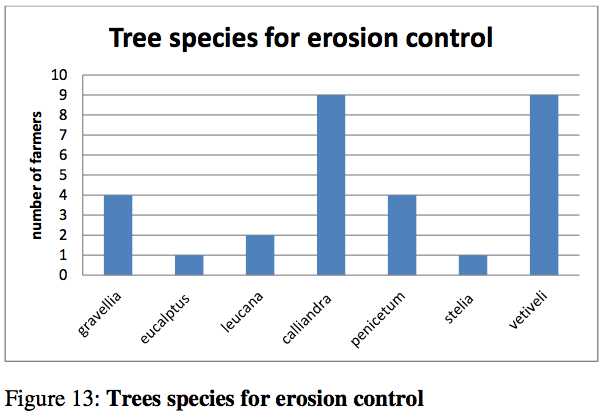
The most dominant species that are grown for erosion control are calliandra and vetiveli. The two species are mostly planted on their crop fields to regulate water movements as Ngororero region is hilly. Almost all farm fields are set on steep slopes, which need water brokers to regulate its speed and making it less severe on crops.
Calliadra fixes nitrogen into the soil to enrich the soil fertility. Vetiveli is a type of grass which is common in the area where survey was conducted. The major role of it is to be used for banana juice extraction from yellow bananas. It doesn’t fix nitrogen but it regulates water movements hence controlling soil erosion and sometimes is used for mulching.
Stelia is used for mulching coffee, banana, and vegetables like cabbage and tomatoes. Penicetum is used to feed animals. Gravellia and Eucalyptus are planted for firewood collection.
The species indicated above are planted depending on the land size simply because some cannot be intercropped with crops. For instance, Eucalyptus and Gravellia need enough isolated places to be productive. Thus, the majority of the farmers cannot afford those.
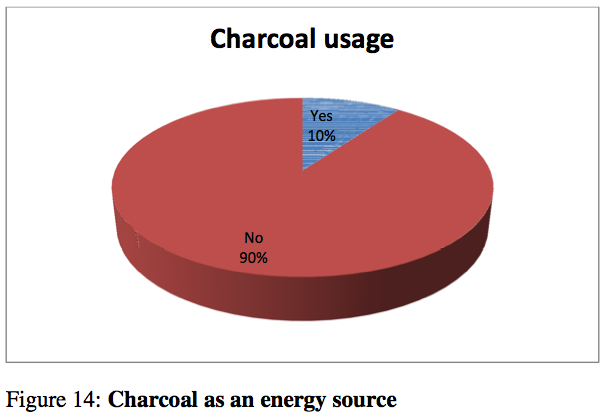
Survey result indicates only 10% of all interviewed households use charcoal as the energy source for food preparation and other energy needs. 90% use other energy sources like firewood.
From the result, one can conclude that the majority of farmers in Ngororero do burn immature trees. This clearly states an obvious need to pave the way towards future development in a sustainable manner by resolving a firewood problem in the region. Without developing other alternative energy sources, the environment might be damaged soon.
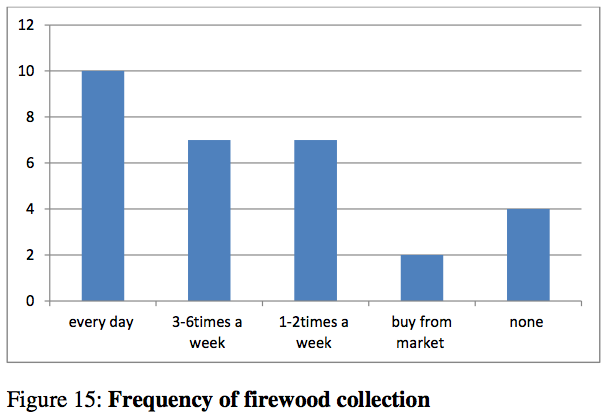
The majority of farmers go to collect firewood every day: according to the graph, 10 people out 30 interviewed collect firewood every day, and seven (7) people go for searching firewood three (3) times to six (6) times a week (and other seven (7) go once or twice a week). Only two buy firewood from a market place around and four (4) people do not collect any firewood.
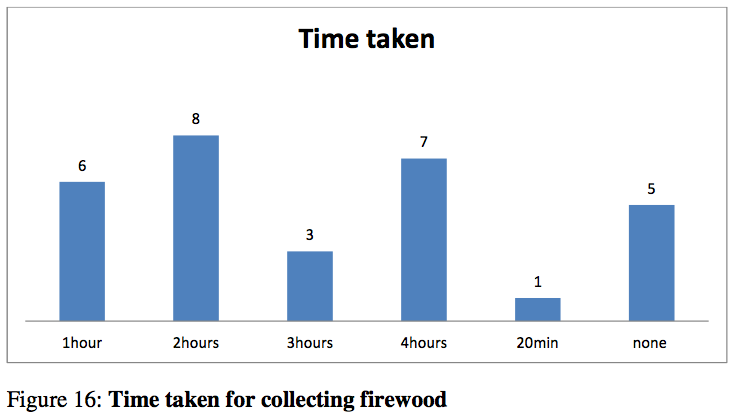
The graph above indicates that a lot of time is spent for searching firewood. By this time consumption, the time for other income generating activities like feeding their animals and planning further agricultural activities, which would improve the farm and innovate off-farm activities, are missed out.
Seven (7) people out 30 interviewed spend four (4) hours looking for firewood where eight (8) households spend two (2) hours searching for firewood almost every day meaning 14 to 28 hours are wasted per week due to firewood searching.
This clearly indicates that much time is wasted for searching an energy source for their food preparation. Therefore, identifying feasible alternative sources of energy can be helpful for local farmers in this region (Nyange) to realize both economic development and environmental protection.
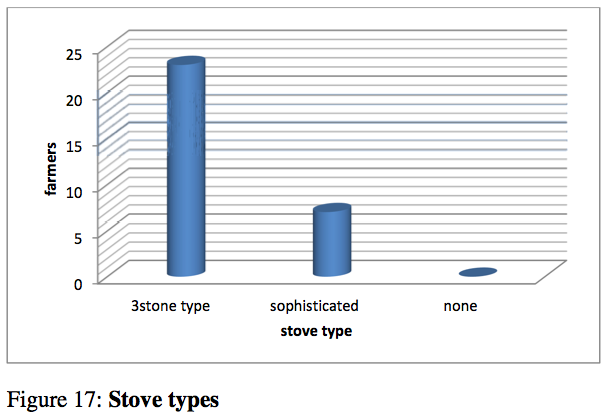
More than 73% of the total people interviewed are still using traditional way of cooking food as the graph above illustrates. The three (3)-stone type is a traditional method used for food preparation, which consumes a lot firewood leading to heavy deforestation and soil erosion.
Sophisticated means of preparing food should be identified in order to save time of local farmers as well as saving the environment. Only 20% use sophisticated means that can save energy sources and not destroy the environment where charcoal is used from mature trees.
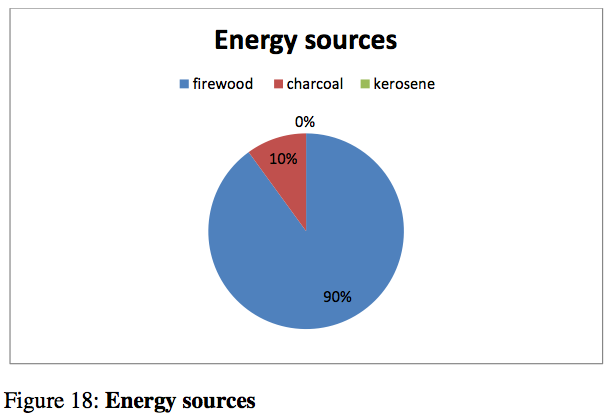
Ngororero survey indicates a serious challenge where the big source of energy for food preparation is firewood as 90% of interviewed people depend on firewood collected from the environment around their houses. Only ten (10) percent of the population interviewed use charcoal as an energy source. And zero (0) percent use any other sources such as kerosene.
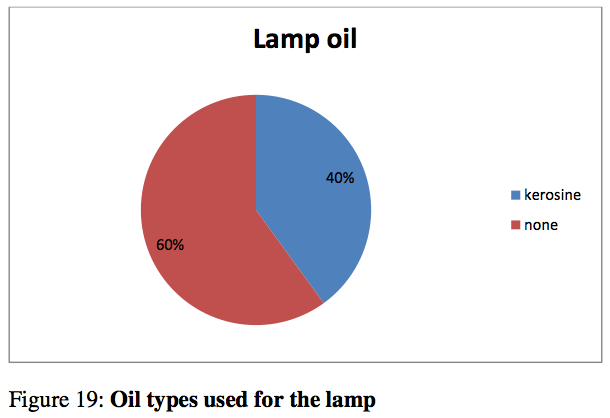
Only 40% of the interviewed population use kerosene for house lightening and 60% use other means apart from kerosene. There is a need to address this problem of using bad quality of kerosene, which is toxic to human health and could even cause eye diseases.
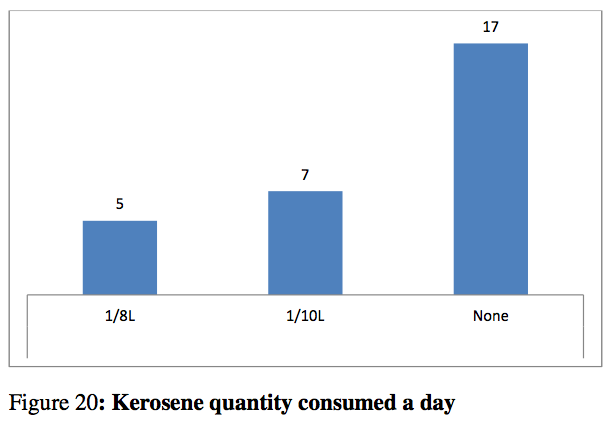
During the survey we discovered that seven (7) people out of 30 people interviewed use 1/10L of kerosene for lightening the house. Five (5) farmers use 1/8L while 17 out of 30 contacted in Nyange sector use other sources of light to lightening the house.
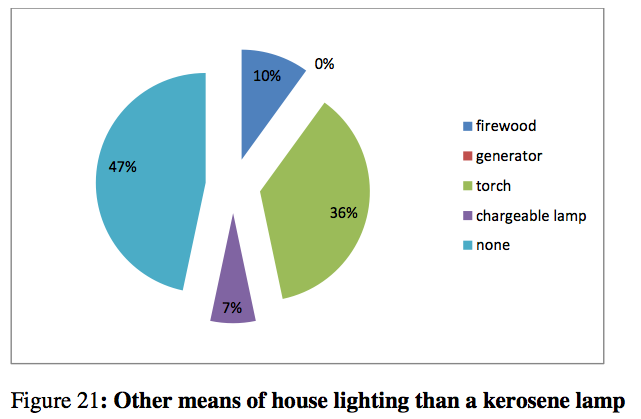
The survey result illustrate that 36% of the population have adopted the system of torching rather than using kerosene. 7% use rechargeable lamps to avoid smoke pollution from burning kerosene for a usual lamp.
This technology of torching innovated by the farmers in Ngororero needs to be developed further so that farmers benefit much from it. The majority of the people using this system explained that waste dry battery cells used for the radio were connected externally and wired to a light bulb. As these dry battery cells may be harmful to the farmers, a rapid evaluation of this locally arranged system must be conducted before disseminating this technology to umudugu in Ngororero District and other rural areas.
